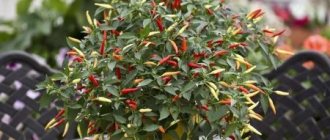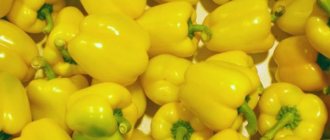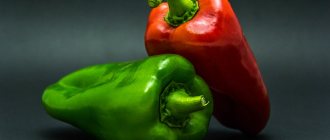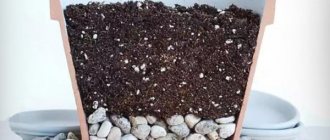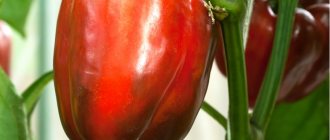The article describes yellow pepper in detail: varieties, recommendations for choosing the best variety, rules for growing and harvesting.
Yellow bell peppers are very popular. Despite the fact that its taste is nothing special and differs little from red, it looks very advantageous both on the table fresh and in preparations for the winter. Although red peppers are more tasty, yellow ones are planted very often due to their unique color. Yellow peppers generally have a medium ripening period, although early and late varieties are also found. They tend to be more popular with gardeners. Before you choose a variety of yellow pepper, be sure to look at its ripening period, which is always indicated on the package. Every gardener plants yellow peppers for a specific purpose, and this must be taken into account before choosing a variety.
Yellow pepper: varieties, detailed description
Yellow pepper: varieties, detailed description
Let's look at the most popular and best varieties of yellow pepper.
Yellow pepper variety Asti yellow
- this variety is early and is most suitable for fresh consumption or for cooking. The bush of this pepper grows up to 75 cm in height. The fruits themselves are shaped more like a cube and have 4 sides. The fruits of this variety grow up to 200 grams. You need to sow this variety of pepper for seedlings already at the end of February, and you need to plant seedlings in open ground already in May and preferably in a greenhouse, because if you want to plant them in open ground, then the ground must be well warmed up. If you want to plant this variety simply in the ground, then you need to install arcs on the selected area and put a film on them. And the entire soil around such a unique greenhouse needs to be thoroughly poured with boiling water, then the earth will warm up very quickly, and it will be possible to plant seedlings.
Cockatoo yellow
- This is a mid-season variety. Basically, Kakadu pepper is recommended for growing in a greenhouse. Its fruits are bright yellow and have a cylindrical shape. One such pepper grows up to 450 grams, and the taste is juicy, sweet and very aromatic. This variety loves heat very much, but air humidity should be minimal.
Yellow pepper variety Golden Miracle
— this variety grows well outdoors in open ground, and is also great for storing for the winter or using fresh. The fruits of this variety are cube-shaped. The ripe fruits of this variety are light green in color, which changes to golden yellow when fully ripe. This pepper grows up to 10 cm in length. It is very sweet and has a pleasant aroma.
Golden Megaton
- This is a hybrid early variety. It is grown in a greenhouse or greenhouse. The bushes of this variety grow 80 cm in height. At the same time, they are lush and powerful. The fruits themselves grow large, weighing up to 300 grams. Therefore, bushes definitely require gartering, because there is a high risk that the bushes will simply break under their own weight. The pulp of this variety is very thick and juicy, sweet and has a very pleasant aroma.
Yellow pepper variety Yellow Bell
is an early variety that grows very well in open ground. Its bushes grow up to 75 cm in height, but require staking, otherwise the seedlings will simply break under the weight of their thick leaves and fruits. The fruits grow large, cube-shaped, with juicy and sweet, very thick pulp. This variety is not very suitable for preparations, so it is best used fresh or for cooking.
Golden Rain
- This variety is well suited for fresh consumption. This is a mid-season variety and grows well both in a greenhouse and outdoors in open ground. Its bushes are lush, grow up to 80 cm in height, and definitely require garter. The shape of the fruits of this variety is original and unusual, resembling a flattened ball or tomato. The fruits are not large in size, weighing only 60 grams, but there are a lot of them on the bush. The lush, green bush is simply strewn with balls, green at first, and yellow at the moment of full ripening.
Yellow pepper variety Golden Barrel
is a mid-season variety that grows well both in open ground and in a greenhouse. The bushes of this pepper grow up to 75 cm in height. Its fruits grow in the shape of a cube and weigh up to 270 grams. They are dark green in color when ripe, but mature peppers turn a bright yellow color. This variety consistently produces a large harvest of sweet and aromatic fruits. This variety is great for cooking and preparing for the winter.
Yellow bison
- this variety, like the previous varieties, is early ripening. Bushes of this variety grow up to 1 meter in height, and produce many large fruits weighing up to 200 grams. A prerequisite for growing Yellow Bison is a garter. If the bushes are not tied up, then the bushes along with the fruits will lie on the ground, which is not very good for the fruits located below on the ground. They will not receive the sunlight they need, they will constantly lie on damp ground, and this threatens them with controversy. And accordingly, after they begin to rot, they begin to rot and you can say goodbye to this harvest. This variety is highly valued by gardeners for its high yield and the fact that it grows remarkably well both in a greenhouse and outdoors, in open ground. Its fruits are long, and they are amazing in that the length of one fruit can be 25 cm. They taste very tender and aromatic. This pepper is well suited for fresh consumption or for storing for the winter.
Yellow pepper variety Gold ingot
— the fruits of this variety grow weighing up to 300 grams, although the bushes themselves are small. They are juicy, sweet golden-orange in color. Gardeners really like this variety because it does not require much care and time. It is also great for dietary nutrition and is very useful for children.
Golden bast shoe
- this variety is mid-early, its bushes are tall and spreading, requiring obligatory garter. The bush is very dense, because the leaves are large, slightly elongated and there are just a lot of them. The fruits of this variety are also large and sweet, distinguished by their ribbing. They are green in color before they are fully ripe, but once they are ripe they turn a bright orange color. The weight of the fruit is generally 150 grams, but some specimens can grow up to 400 grams. So it is best to tie up such bushes.
Yellow cube
— the fruits of this pepper look very impressive. They are large, beautiful, grow in the shape of a cube, weighing up to 300 grams and have 4 sides. They grow the same in length and width, up to 12 cm. When ripe, they are bright yellow, and the bush itself can grow up to 1 m in height. Accordingly, such huge bushes must be tied up.
Big gold
- This variety is early ripening. It is mainly recommended to grow it in open ground. Its golden-yellow fruits contain a lot of vitamin C. Therefore, this pepper is very useful when eaten fresh. Although it is also very good for preparing for the winter or freezing.
Golden pyramid
- This is an early ripening variety. Its fruits are elongated and bright yellow. They are very sweet and have a very strong aroma. Basically, one fruit grows up to 100 grams, but there are some specimens that grow up to 250 grams. The bushes themselves grow to medium size and they partially need a garter. That is, not all bushes in a row, but only those that have grown taller than the rest, and the fruits on such bushes often grow larger. And accordingly, such bushes are more susceptible to breakage.
Golden Cup
- a mid-late variety that grows both in open ground and in greenhouses. Its bushes grow of medium size, but are very fluffy due to the fact that they have a lot of leaves. The fruits of this pepper grow in the shape of a cube, long and therefore up to 10 cm wide, and weighing up to 200 grams. When the fruits ripen they are yellow in color and are perfect both fresh and for preparations.
gold reserve
- this variety is relatively new, but already very popular among gardeners. Its fruits are very sweet and dense. And in terms of ripeness it is a mid-early variety. Its bushes are fluffy, have many leaves, but grow only 60 cm in height. But the weight of the fruit is 200 grams. When ripe, peppers have a yellow-orange color and grow up to 10 cm in length. The fruits of this pepper are very good both fresh and in preparations. And due to its color it looks very beautiful and adds variety.
Golden Toastmaster
- This variety is unusual. Mid-season and its fruits look very similar to tomatoes. The bush grows only up to 55 cm, is very dense and is a bit like an egg in shape. When the fruits of this variety are fully ripe, they become golden yellow in color, weighing up to 180 grams. This variety has good immunity and is resistant to wilting. Pepper of this variety can be grown both in a greenhouse and in open ground. You can also grow it even at home on the windowsill. This variety is most popular among gardeners due to the fact that these small compact bushes produce fairly large fruits. And due to the shape of the bush, it itself looks very original.
Golden Taurus
- this variety is mid-early, and its bushes grow up to 75 cm in height. But its yellow-orange fruits are very large, fleshy and juicy. They grow in weight from 250 to 500 grams, so the bushes must be tied up, because under the weight of the fruit they can easily break. Moreover, the fruits of this plant are very well suited both for fresh use and for preparation and canning.
Yellow banana
— this mid-season variety got its name for a reason. Because its fruits are elongated and can grow up to 25 cm in length. This variety is high-yielding, peppers grow up to 150 grams, and there are a lot of them on one bush. And it is best to tie the bushes themselves so that the fruits do not lie on the ground, but are cheerful. Before ripening, the fruits are green, which later become yellow, and some specimens have an orange-red tint.
Golden Jubilee
— the bushes of this variety are very compact, growing only 30 cm in height. The fruits on this bush grow in the form of a bouquet. This variety is especially popular due to the fact that it can grow both in a greenhouse and outdoors in open ground, but surprisingly at home on a windowsill it will bear fruit just as well. In order for the harvest to be large, peppers need to be planted as close to each other as possible so that they are well pollinated. You can also help the pollination process by growing this pepper at home. Take a soft brush and carefully transfer pollen from flower to flower. The main thing is not to damage the flowers themselves. Accordingly, since the pepper bushes are very small, weighing only up to 70 grams, but slightly elongated in shape. The surprisingly ripe fruits of this variety are reddish in color.
White gold
- this variety of pepper is early ripening and low, the bush grows only 50 cm in height. But its fruits are surprisingly huge, they grow up to 450 grams. The color of the pepper is very beautiful, pearly yellow. It is excellent for fresh consumption and for preparations. It can also grow in a greenhouse and in open ground.
Giant yellow f1
— this early-ripening hybrid is created both for cultivation, both in open ground and in a greenhouse. The height of the bushes of this plant grows up to 80 cm, and the fruits weigh up to 250 grams. This variety, like many others, must be tied up otherwise they may break. The pulp of this hybrid is dense, but juicy and very sweet in taste. It is best suited for fresh consumption.
Yellow monster
- this variety is universal, elongated in shape and grows up to 20 cm in length and up to 10 cm in width. These large fruits are very sweet in taste, fleshy and very juicy. When fully ripe, the fruits are bright yellow. The bushes of this variety must be tied up so that the fruits do not touch the ground because they are very long. This variety is most suitable for cooking, but is not very suitable for canning.
Yellow prism
- this variety is mid-early. Its bushes grow up to 80 cm in height, and the fruits weigh up to 200 grams. The pulp of this variety is very juicy and aromatic. Don’t forget that since the bushes are tall, they also need to be tied up, otherwise they will simply break.
Yellow bull
- This is a mid-early variety that produces large fruits. Peppers of this elongated variety easily grow up to 20 cm in length and weigh 200 grams. Its pulp is dense and very juicy, sweet in taste. Mostly this pepper grows in a greenhouse. The higher the air temperature in the greenhouse, the greater the harvest you will get. But always keep in mind that air humidity should be minimal.
Golden pheasant
- This is a mid-season variety. Its bushes grow up to 60 cm, but have large fruits weighing up to 300 grams. The flesh of medium-hard peppers tastes very sweet and has a pleasant aroma. Externally, the fruits are round in shape, slightly flattened, somewhat similar to tomato fruits. This variety grows well outdoors in open ground. It is very suitable for fresh consumption, cooking and simply storage.
Golden autumn
- this mid-early variety is universal, grows well both in a greenhouse and in open ground. The bushes of this variety grow up to 80 cm in height. The fruits are elongated, growing up to 170 grams. This variety can be gartered selectively, only the tallest bushes. This variety is good for fresh consumption or cooking, as well as for winter storage.
Hungarian yellow
- this variety is early, and what is most surprising is that it tolerates cold well. Gardeners really like it due to the fact that it grows well both in a greenhouse and in open ground. And another advantage of this variety is that it can even grow at home on a windowsill. The bush grows only 50 cm in height and has fruits that grow up to 60 grams. The color of the fruit is glossy, bright yellow. Moreover, this variety is high-yielding, and this is another big plus for it. It is best used fresh or as a decoration for dishes, because it looks very decent on the table. But this variety is not very suitable for preparations.
Golden Miracle
The Golden Miracle variety has been grown since 2007. It was created by breeders. The ripening period of pepper is 70-80 days. By this time, the fruits reach technical ripeness. They stay green. The dark yellow color of the pulp appears later:
| № | Helpful information |
| 1 | the pepper has the shape of a prism, weighs 185 g. The thickness of the pulp is 7 mm |
| 2 | 2.7 kg of yellow berries are collected from one bush under a film cover |
| 3 | capsicum Golden Miracle does not suffer from Fusarium wilt. The culture is resistant to night cold snaps in spring and autumn |
The Golden Miracle is grown both under film and in open garden beds. After planting, young seedlings are covered with film. When the adaptation period passes, the film is removed. When planting in a greenhouse, seedlings are placed at a distance of 1.5-2 m from the door and from the windows.
More on the topic: How are Chocolate Round Dance peppers grown?
Otherwise, the plants will be exposed to temperature changes. This can cause stress; leaves and stems turn yellow, flowers and ovaries fall off.
When growing pepper, it is necessary to organize a certain microclimate for it. The normal temperature for intensive development of the ovary is 22-25 C.
Heat-resistant varieties bear fruit at 25-28 C. Stress-resistant crops can show their productivity at 18-20 C.
Yellow pepper: varieties. How to choose the right variety
Yellow pepper: varieties. How to choose the right variety
Of the entire variety of yellow pepper varieties, you initially need to thoroughly study the characteristics of the varieties and their features. Indeed, despite the fact that red peppers are slightly tastier than yellow ones, gardeners prefer them due to their color, which looks beautiful both in cooking and in winter preparations. Yellow pepper also contains a lot of phosphorus and potassium, which are simply necessary for the human body. And this particular pepper is great for feeding children, because it is considered dietary. Yellow pepper also contains a lot of pectin, fiber and essential oils. This pepper also contains cellulose, which is simply necessary for humans. In addition, this pepper contains vitamin C and ascorbic acid, which is known to improve human immunity well. Pepper also contains vitamins B and PP, A and E. It also contains iron, calcium and other trace elements. So yellow peppers are a storehouse of vitamins. And yellow pepper also contains the so-called “happiness hormone”, which it contains even more than chocolate. And due to the fact that pepper is a dietary product, its use will not add one gram of excess weight to you. It is yellow pepper that is included in many recipes, and it is very common in cooking. And in winter preparations it simply looks very aesthetically pleasing and beautiful. And yellow peppers can be stored longer than red peppers without losing their appearance and beneficial properties.
Cooking tips
Red and yellow bell peppers (the difference in flavor will be minimal) can be stuffed, baked, grilled, broiled, pureed for soups and sauces, or used in stews, sauces and dressings. It can also be eaten raw, put on a sandwich, and added to salads. When using pepper in cooking, you must follow these three principles:
- minimum required thermal exposure;
- minimum required cooking time;
- minimum necessary contact of fruit with oil or fat.
There are many recipes using pepper. Use already known ones or come up with your own. Here are just a few ideas:
- add finely chopped bell peppers to tuna or chicken salad;
- To prepare a simple Creole dish, combine pre-chopped peppers, celery, onions, tofu, chicken or seafood;
- Make a delicious, refreshing puree of roasted and peeled peppers, onions and zucchini soup that can be served hot or cold.
Yellow bell pepper: growing and care
Growing and caring for yellow peppers is not as difficult as it seems. Yes, and it can be planted for several years in a row in the same place, and it does not require any special requirements for the composition of the soil. Of course, there are varieties of pepper that need to be grown only in a greenhouse, but there are also a large number of varieties that grow well in open ground. If you grow yellow peppers in a greenhouse or warm greenhouse, then you can plant seedlings after May 5th. But if it grows outside, just in open ground, then it is planted only after May 20th. The timing of direct planting depends on how well the soil in which it will grow has warmed up. If you want to plant peppers outside earlier, then install arcs in the ground and cover this area with film. And the soil around such a unique greenhouse needs to be spilled with plenty of hot water. And there are also many more ways to warm the planted pepper, ventilate and harden it during the day, and be sure to close it at night. But still, experienced gardeners recommend not to rush into planting this heat-loving plant until the earth warms up on its own and a consistently warm temperature is established outside, which will not differ much between day and night. Usually at the end of May the foliage grows very abundantly, and the bushes become very beautiful and lush. Also, before transplanting peppers, gardeners very often pay attention to the lunar calendar. After transplanting, it is not recommended to water the pepper too often; this should be done only when the soil dries out. You also need to remember that pepper can only be watered with warm water. The cold will cause stress on the plants, which will not have a very good effect on the plants themselves and subsequently on the future harvest. And for the entire season, peppers are fertilized as planned only three times per season; the rest of the fertilizers are needed unscheduled, depending on the condition of your plants.
Reviews
We invite you to read reviews about the use of yellow bell pepper.
Elena Kosheleva, mother on maternity leave : “Before pregnancy, I didn’t really like bell peppers. I ate it in a Greek salad, but wasn't thrilled. I liked the color palette of the salad, which the colorful vegetables gave the dish. But in the third month of gestation, she sharply changed her opinion about him. She especially leaned on yellow fruits. I noticed how the absent-mindedness and tearfulness characteristic of pregnant women gradually went away. I began to get enough sleep and stopped being afraid of childbirth. In terms of strengthening the nervous system, the vegetable helped me a lot. I won’t say anything about the beauty of my nails and hair, but there were no big problems with it.”
Victor, 35 years old : “I can speak from my own experience about the benefits of bell pepper for concentrating attention and increasing performance. During periods of high workload, when I need to close several orders in a short time, I prepare myself a pepper “bomb” - a salad with several types of bell peppers. Helps. I deliver everything on time. Fatigue is minimal. True, the appetite increases significantly.”
Nikolai, a young pensioner : “The fact that only women do not want to grow old is not true. Everyone is afraid of old age. I am running away from it as best I can at 62 years old. In the morning I run in the park, in the evening I swing dumbbells. And at lunch I found a way to distance myself from her - every other day I eat a large yellow pepper. A therapist I know recommended. I must say, I feel cheerful. Got rid of heart problems. They were not critical. But still there were.”
Yellow pepper: varieties, how to feed sweet yellow pepper
The first time the pepper needs to be fed nitrogen, 1 liter of manure is diluted in a bucket of warm water. The second time, potassium and phosphorus need to be added as fertilizers. If the first fertilizing needs to be done two weeks after planting the seedlings, then the second fertilizing must be done before flowering begins. For this feeding you need to dilute potassium and 2 tablespoons of superphosphate in 10 liters of warm water. The third feeding is carried out at the moment when the pepper fruits begin to actively grow. To do this you need 2 tablespoons of superphosphate and a glass of pure wood ash without impurities. This mixture should be diluted in a bucket of warm water and left to infuse for two days, and only then should this infusion be poured over each pepper bush. Also, do not forget that if your bushes are tall enough and also fluffy, then they simply need to be tied up. Otherwise, they simply will have nothing to rely on, and they may break under their own weights, and even more so if there are a lot of fruits on the bush, it is even more susceptible to fracture. But if the bush is small, then tying it up is not required.
Yellow pepper: varieties, harvesting and seed features
Typically, peppers begin to be harvested when they are ripe and match the color indicated on the package. But just as often, the harvest is harvested when it is not yet ripe, then it will be better stored. Unripe peppers are removed from the bush and peeled, then packed tightly into boxes and stored in a dark place at room temperature. In this form, after a few days the peppers ripen and acquire shades of different colors. But those fruits that are left to grow on the bush, thanks to the space, begin to grow faster and better, and also become fuller, which is why they will be more juicy and sweet. And due to the fact that there are few fruits left on the bush and they do not need to compete with each other, and in this case the fruits that remain on the bush receive much more nutrients and vitamins. So if you decide to grow yellow pepper, be sure to study all the characteristics of the variety, the conditions for proper planting, watering, fertilizing and caring for this pepper. Then you will always be pleased with the quantity and quality of the harvest, which will a priori be rich. In general, yellow peppers are simply a storehouse of vitamins and nutrients. And if you really like the variety you grew, you can collect its seeds yourself. To do this, the pepper must ripen and even overripe to such an extent that it becomes dark and wrinkled. This fruit needs to be cut and the seeds removed. They need to be dried and stored in a dark place. And next year, before planting, they need to be poured into a glass of water and those that float to the surface should simply be thrown away, because they do not germinate. But those that remain at the bottom of the glass can be safely planted as seedlings.
Yellow pepper: varieties
Golden-Maned Lion
Capsicum Golden-maned Lion was created by breeders from Novosibirsk. The culture is mid-season. During the period of technical ripeness, the fruits are dark green. The rich yellow hue of the berry is obtained 80 days after the appearance of young shoots:
- the shape of the fruit is cylindrical;
- average weight 166 g, wide wall, 9 mm;
- when grown in open ground, up to 6 kg/m2 is obtained.
The bush grows up to 80-90 cm, spreading is average. It is recommended to form the plant into 3 branches. Stepchildren and weak ovaries are removed. It is recommended to tie up the bushes and use trellises.

